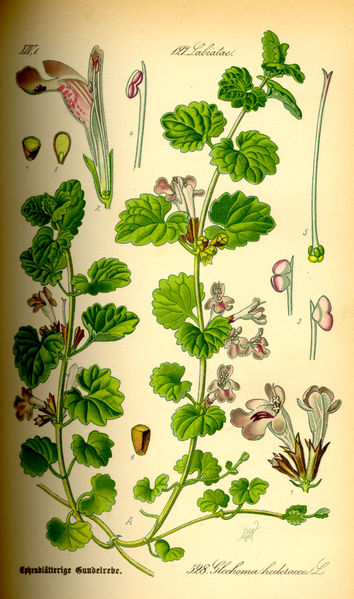 Image from Wikipedia, source: Prof. Dr. Otto Wilhelm Thomé Flora von Deutschland, Österreich und der Schweiz 1885, Gera, Germany [This post is my contribution to the Blog Party being hosted by an amazing herbalist, Darcey Blue French, at http://desertmedicinewoman.blogspot.com/ on the theme of "Weeds of Summer that you love to love, that others love to hate...."]
Image from Wikipedia, source: Prof. Dr. Otto Wilhelm Thomé Flora von Deutschland, Österreich und der Schweiz 1885, Gera, Germany [This post is my contribution to the Blog Party being hosted by an amazing herbalist, Darcey Blue French, at http://desertmedicinewoman.blogspot.com/ on the theme of "Weeds of Summer that you love to love, that others love to hate...."]Weeds are the outlaws of the plant world -- plants that escape cultivation and resist eradication, slipping in where they aren't wanted, subverting the gardener's idea of control. Medicinal allies of the common people, dismissed by the medical profession throughout history (think of the plants whose Latin binomials contain the word
vulgaris.)
Neither of Ground Ivy's Latin names (
Glechoma Hederacea or
Nepeta Glechoma) contain the word vulgaris, but Ground Ivy otherwise fits the definition well. According to a website maintained by
Purdue University's School of agriculture "
Ground ivy is difficult to control and it is a problem in 31% of lawns maintained professionally in Indiana." The
State of Connecticut officially made Ground Ivy an outlaw, banning its cultivation in 2004. They were, of course, a bit late -- the tiny creeping mint came over with the first colonists who used it to make medicine and ale.
(Alehoof was a common name for the plant a few hundred years ago, reflecting its use as a bitter in beermaking prior to the standardization of beer composition that began with the German Beer Purity Law of 1516, a law designed in large part to end the production and consumption of psychotropic and aphrodesiac beers. See Stephen Harrod Buhner's
Sacred and Healing Herbal Beers for more on this history.)
Ground Ivy was popular in British and American folk medicine well into the nineteenth century.
Maude Grieve wrote:
"From early days, Ground Ivy has been endowed with singular curative virtues, and is one of the most popular remedies for coughs and nervous headaches. It has even been extolled before all other vegetable medicines for the cure of consumption. "An excellent cooling beverage, known in the country as Gill Tea, is made from this plant, 1 OZ. of the herb being infused with a pint of boiling water, sweetened with honey, sugar or liquorice, and drunk when cool in wineglassful doses, three or four times a day. This used to be a favourite remedy with the poor for coughs of long standing, being much used in consumption. Ground Ivy was at one time one of the cries of London for making a tea to purify the blood. It is a wholesome drink and is still considered serviceable in pectoral complaints and in cases of weakness of the digestive organs, being stimulating and tonic, though it has long been discarded from the Materia Medica as an official plant, in favour of others of greater certainty of action. As a medicine useful in pulmonary complaints, where a tonic for the kidneys is required, it would appear to possess peculiar suitability, and is well adapted to all kidney complaints"
Despite (or more likely because of) its popularity, Ground Ivy was not well regarded by physicians of the late nineteenth and early twentieth centuries. In 1869,
William Cook wrote that
"the marvelous repute it once enjoyed in England, has very properly faded away." The 1918 edition of the
Dispensatory of the United States of America said:
"The herb was formerly official, and still enjoys some credit as a domestic remedy. It has a peculiar, disagreeable odor, and a bitterish, somewhat aromatic taste, and imparts its properties to boiling water. It is very prone to have galls developed on it, and to be infested with certain fungi."
But in recent years, the herb has made its way back into medicine, and even into commerce.
I was introduced to Ground Ivy by Madelon Hope of the
Boston School of Herbal Studies who spoke of the plant's affinity for the upper respiratory system I gathered the flowers this spring and tinctured them in 80 proof Vodka. The tincture was ready just as I had a number of clients come to me complaining of head colds marked by severe sinus congestion, slight throat irritation and inflamation, and minor swelling of the lymph nodes in the throat. I used Ground Ivy in a formula with Yarrow and Elder Flowers and Berries at a dosage of 30-60 drops every 4 hours depending on body weight, and most clients reported relief from all symptoms by the end of the first day. I have found Ground Ivy very effective in relieving my own sinus congestion and inflamation.
David Winston speaks of several uses I have not yet explored in his section on the plant in his
American Extra Pharmacoepia, including:
- clearing toxic heat from the liver and gallbladder and promoting bile excretion
- getting the blood moving and reducing swelling in traumatic injuries
- increasing lead excretion in urine
Winston also notes that Ground Ivy has antiviral qualities -- which supports the emerging sense among many herbalists that rapidly spreading plants tend to be effective in treating rapidly spreading diseases.
This little outlaw who grows close to the ground and quickly overtakes yards and pastures is fast becoming one of my favorite medicinal plants.
 The forests and fields of Maine have blessed me with great abundance this year -- and I am offering the first in my line of ethically wildgathered Tinctures and Flower Essences for sale.
The forests and fields of Maine have blessed me with great abundance this year -- and I am offering the first in my line of ethically wildgathered Tinctures and Flower Essences for sale.
